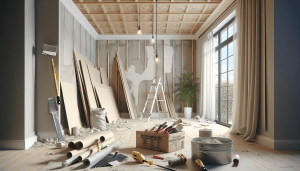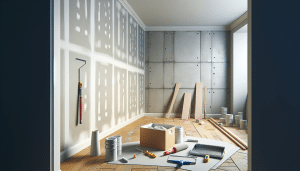Drywall damage can be frustrating for homeowners. If you’ve stumbled upon unsightly dents or holes, look no further. At Utah Drywall & Repair, we’re here to walk you through fixing those issues yourself, one step at a time. From the simplest patch job to more significant fixes, this guide will help you become a DIY drywall hero!
Contents
Identify the Damage
Before diving in, it’s crucial to understand the type of damage you’re dealing with. Are there small holes from nails or dents from furniture? Identifying the damage will help determine the appropriate repair method. This will also ensure you have the right tools and materials on hand.
Small holes, for instance, can be quickly patched up with some spackling, while larger holes might require a mesh patch and additional tools. Dents, on the other hand, might just need some Sanding and a bit of joint compound. Knowing what you’re up against makes the repair process smoother and more efficient.
Gather Your Tools and Materials
Having the right tools and materials is essential for a successful Drywall Repair. Here’s a list of items you’ll need:
- Joint Compound: This is the filler that will cover holes and seams, creating a smooth surface.
- Drywall Tape: Necessary for reinforcing joints and seams.
- Sandpaper or Sanding Sponge: Used to smooth down the joint compound once it’s dry.
- Putty Knife: Ideal for spreading joint compound evenly.
- Mesh Patches: Useful for covering larger holes before applying compound.
Preparing the Area
Preparation is key to a flawless finish. Start by clearing the area of any debris. Make sure your working surface is clean and dry.
Next, use a utility knife to cut away any loose paper or plaster around the damaged area. This step ensures that the new compound adheres properly, giving you a seamless repair. Don’t skip this part; it’s essential for long-lasting results.
Small Hole Repairs
Dealing with small holes is relatively straightforward. Begin by applying a small amount of joint compound to the hole using a putty knife.
Spread the compound evenly and feather the edges to blend it with the surrounding wall. Allow it to dry according to the manufacturer’s instructions. Once dry, sand the area with fine-grit sandpaper until smooth, then apply a second coat if needed. Sand again, and your wall should be as good as new!
Fixing Larger Holes
For larger holes, you’ll need a mesh patch. Start by placing the patch over the hole and pressing it down firmly. This patch will serve as the foundation for the compound.
Apply joint compound over the patch, using your putty knife to spread it evenly. Make sure to feather the edges so the patch blends seamlessly with the wall. Allow this to dry, then sand it down. You may need to repeat this process to achieve a smooth finish.
Sanding
Sanding is a crucial step. Once the compound is completely dry, use fine-grit sandpaper or a sanding sponge. Sand in a circular motion to achieve a smooth surface.
Wipe away any dust with a damp cloth before applying additional layers of compound or before priming and Painting. This will ensure that your final result is free from any imperfections.
Priming the Repaired Area
Priming is an often overlooked step but is incredibly important to ensure paint adheres well. Apply a coat of primer to the repaired area.
This seals the joint compound and prepares the surface for paint. Allow the primer to dry completely. This step ensures that the color and texture of the paint match seamlessly with the rest of the wall.
Painting
Finally, it’s time to paint. Use the same paint and finish as the rest of your wall. Apply thin, even coats for the best results.
Allow the paint to dry according to the manufacturer’s instructions before applying additional coats. This will help the repaired area blend in perfectly with the rest of your wall, making it look like new again.
Maintaining Your Drywall
To keep your drywall looking pristine, it’s essential to practice good maintenance. Avoid dragging furniture against walls, and address small dents and holes as soon as they appear.
Regularly inspect your walls and touch up any areas that show signs of wear. This proactive approach will save you from more significant issues down the line and keep your home looking its best.
Conclusion
Fixing drywall might seem daunting, but with the right tools and a step-by-step approach, it’s entirely manageable. For larger, more complicated repairs or if you simply prefer professional assistance, Contact Us at 801-406-6350 or Request a Free Quote.




